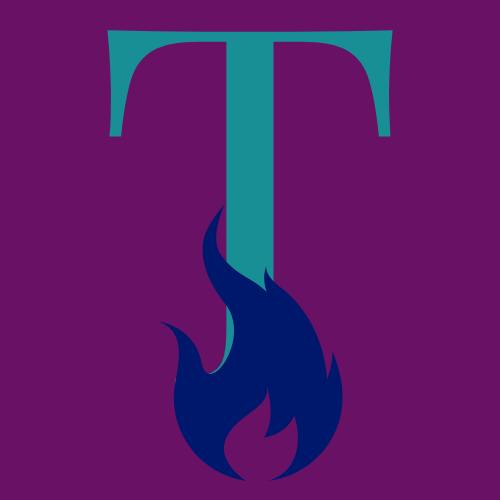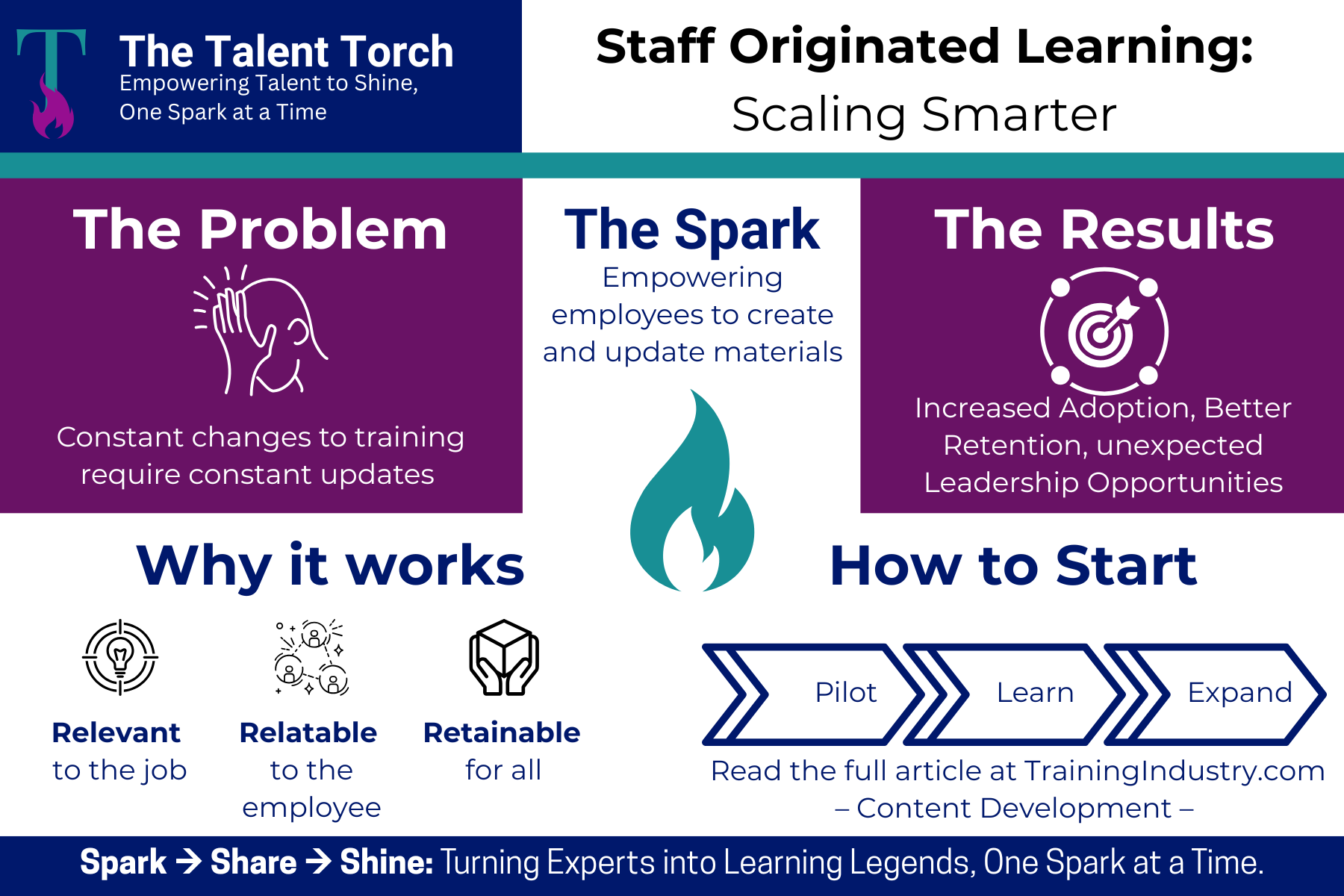Unleash Your Team's Genius: Staff Originated Learning (SOL)
Cheryl Haga - April 10, 2025
Feeling overwhelmed by training that just doesn’t keep up? If you spend too much time updating old content, it’s time to try something different! You have a treasure trove of knowledge just waiting to be shared! Staff Originated Learning (SOL) transforms your internal expertise into learning experiences that are a win-win. Staff get to share their unique skills, and everyone enjoys fresh, practical information that keeps everyone in the loop!
One of my old teams was facing a challenge. We had a powerful new AI software, but adoption was slow across the company. Teams were clinging to old ways and struggling to make the transition. Instead of expensive external training or relying on the bland training provided by the software, we proposed an alternative solution: Employee-Generated Content. With a vision of short, practical video tutorials created by the people who use the software daily – our colleagues. Armed with smartphones and screen-capturing software, we got to work. We rallied a small team of "software champions" from different departments, each focusing on the features they found most helpful.
The resulting wiki library of bite-sized videos was a hit. Employees could quickly find answers to specific questions, watch tutorials on their phones during their commute, and learn at their own pace. Software adoption skyrocketed, and efficiency improved dramatically. But the biggest surprise was for the employees who helped create the content. Their ability to connect with their colleagues and demonstrate strong communication, agility, persistence, and expertise shone through. Many of the videos were recognized by senior leadership, and many participating in the ECG became team leads for other initiatives and were tapped for more senior opportunities.
Why Staff Originated Learning (SOL) Works:
SOL works for employees, training teams, and leaders because it’s relevant, engaging, and accessible. After all, who knows your business better than you and the staff? SOL focuses on the challenges and processes of the people who do the work daily. Seeing someone you work with daily walk through the steps, is much more engaging than reading an SOP or hearing someone walk you through it.
The biggest advantage from a business perspective is that the knowledge is captured and stays with the business. So before that senior colleague retires or moves to another company, they have captured the processes, tips and tricks, and best practices so everyone can continue performing at a high level.
Getting Started
We can’t assume everyone knows how to create compelling learning content. We’ve ALL sat in those ‘trainings’ where someone talks at us for 45 minutes and then asks for questions at the end, all the while we are screaming (on the inside) “TELLING ISN’T TRAINING”!
Training: Content Creation Basics
We need to start with the basics of storytelling. I like to provide a template that shows a logical information structure so that the staff - the creator - can focus on the actual content and not as much on how to organize it. Think of this as the Graphic Organizers teachers use in classrooms! Sharing examples and showing how it was done is incredibly effective. (Consider having your closest business unit colleague do the first one with you as an example!)
Include reminders about safety, copyrights, Intellectual Property, and other company policies that might apply. For example, there might be a policy that you can’t use your personal phones to take pictures or videos. If that’s the case, be sure to provide alternatives so that everyone is able to participate but still adhere to the company's expectations.
Support isn’t a one-time event. You’ll want to set up ongoing opportunities for the training experts to work with staff. As your colleagues become more comfortable sharing information, they will want to grow and expand their capabilities. Provide them with office hours, additional templates, tool training, etc., so they can. This is a win-win-win for training and L&D teams.
Culture: Fostering a Sharing Mindset
A supportive culture is essential for SOL to thrive. Getting the leaders on board is very important – when they're visibly excited about SOL, and jump in to help, everyone notices! We also need to communicate the advantages of SOL, both for the staff creators (new skills, getting noticed, and even career boosts) and for the company (better learning, keeping knowledge in-house, and saving money). And of course, we must celebrate everyone who shares their knowledge – whether it's a shout-out in the newsletter, a quick "thanks" at the team meeting, or even a small token of appreciation.
To encourage widespread adoption of SOL, minimize any friction in the process. This means streamlining content creation and sharing as much as possible, providing readily available templates, clear guidelines, and user-friendly tools. Building a strong community around SOL is equally important. Opportunities for staff creators to connect, exchange ideas, and learn from one another, perhaps through online forums, regular meetups, or even informal coffee breaks. Finally, leadership should lead by example. Encouraging senior employees and subject matter experts to actively contribute sets a positive precedent and demonstrates the value of knowledge sharing throughout the organization.
Organization: Making Knowledge Accessible
For SOL to be truly effective, we need to organize it logically. This means establishing a clear structure for categorizing and tagging content, perhaps by topic, department, skill level, or content type. A robust search function is also essential, enabling everyone to quickly locate the information they need. We also need to actively promote the SOL library and make content discovery easy. This could involve featuring new or relevant content in newsletters, on intranet pages, or during team meetings.
To ensure the quality and relevance of SOL, we should designate individuals or teams to curate and review the content. This process will help maintain consistency and weed out any outdated or inaccurate information. It's also important to establish a process for regularly reviewing and updating SOL to keep it fresh and relevant for our teams.
Start Small: Pilot, Learn and Grow
Don't try to boil the ocean. A phased approach is much more effective. A smart way to launch SOL is with a pilot program. We should select a specific team or department to test our approach and learn from any hiccups before rolling it out company-wide. Getting feedback from the pilot group throughout the process is key – we need to know what's working and what's not. Based on that feedback, we can refine our SOL strategy, processes, and tools. Once we've seen success with the pilot, we can gradually expand the program to other teams and departments.
Feedback: The Continuous Improvement Loop
Feedback is crucial for the long-term success of the SOL program. To keep it thriving, we need to actively seek feedback. Regular surveys are a great way to gather input from both content creators and learners. We should also hold focus groups to gain more in-depth insights into the program's effectiveness. Finally, let's create open communication channels, like online forums or suggestion boxes, to make it easy for everyone to share their thoughts anytime.
To really understand how SOL is performing, we should track content usage data like views, downloads, and comments to see what resonates with folks and what doesn't. But gathering feedback is only half the battle—we need to actually act on it! Making changes to our SOL strategy based on what we learn shows everyone that their input matters and helps us improve the program over time.
Conclusion
Remember the AI software adoption problem? We solved it with employee-generated video tutorials, boosting adoption and efficiency while also highlighting the talents of our content creators. SOL works because it's relevant, engaging, and accessible. No one knows your business better than your staff! It captures valuable knowledge and keeping it within the company even when employees leave. Take the first step today! Identify a pilot team and start building your internal knowledge base. Your team's genius is waiting to be unleashed.

